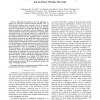Free Online Productivity Tools
i2Speak
i2Symbol
i2OCR
iTex2Img
iWeb2Print
iWeb2Shot
i2Type
iPdf2Split
iPdf2Merge
i2Bopomofo
i2Arabic
i2Style
i2Image
i2PDF
iLatex2Rtf
Sci2ools
RTSS
2009
IEEE
2009
IEEE
Multi-Channel Interference Measurement and Modeling in Low-Power Wireless Networks
Abstract—Multi-channel design has received significant attention for low-power wireless networks (LWNs), such as 802.15.4-based wireless sensor networks, due to its potential of mitigating interference and improving network capacity. However, recent studies reveal that the number of orthogonal channels available on commodity wireless platforms is small, which significantly hinders the performance of existing multichannel protocols. A promising solution is to explore the use of partially overlapping channels for communications. However, this approach faces several key challenges such as increased inter-channel interference and significantly higher overhead of channel measurement. In this paper, we systematically study the inter-channel interference and its impact on link capacity and the performance of multi-channel protocols in LWNs. First, we develop empirical models for characterizing inter-channel signal attenuation based on experiments on TelosB motes. We then propose a novel ...
Applied Computing | Inter-channel Interference | Interference Measurement | Low-power Wireless Networks | RTSS 2009 |
| Added | 21 May 2010 |
| Updated | 21 May 2010 |
| Type | Conference |
| Year | 2009 |
| Where | RTSS |
| Authors | Guoliang Xing, Mo Sha, Jun Huang, Gang Zhou, Xiaorui Wang, Shucheng Liu |
Comments (0)

